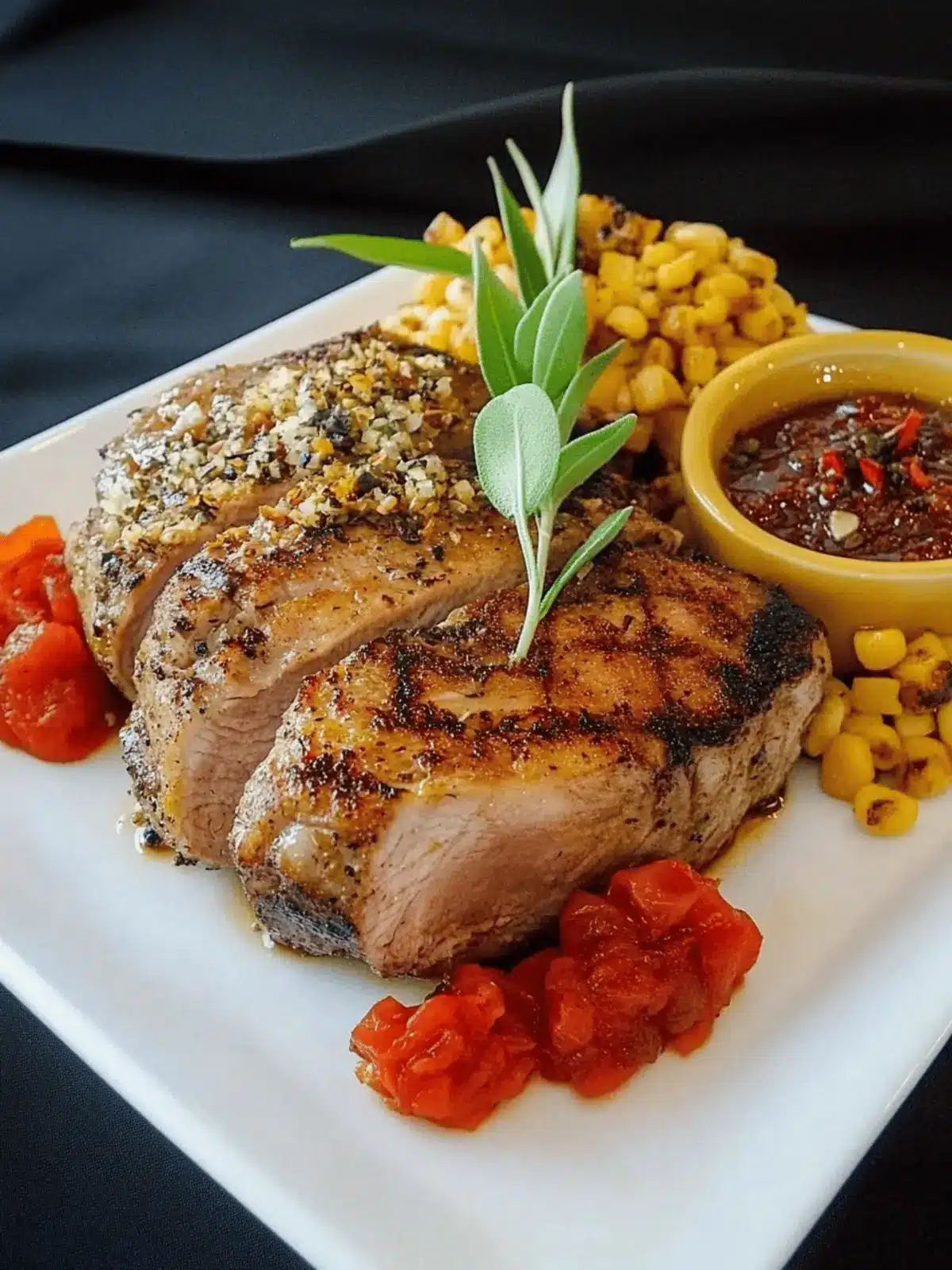The moment I took my first bite of Pueblo Pork Roast, I was transported to the sun-soaked landscapes of the Southwest, where bold flavors and indigenous traditions meld into something extraordinary. Imagine the rich aroma of a savory sauce simmering with tomatoes, honey, and a whisper of bittersweet chocolate—that’s the kind of magic simmering in your kitchen when you prepare this dish.
This recipe not only celebrates the comforting warmth of home-cooked meals but also pays homage to the authentic cuisine of the indigenous peoples of the USA. With its tender pork rib roast bathed in a lavish sauce, this main course turns any gathering into a feast to remember. Plus, it’s surprisingly easy to make, ensuring you’ll spend less time in the kitchen and more time enjoying the company of family and friends. Get ready to impress your guests with this flavorful journey to the heart of indigenous cooking!
Why is Pueblo Pork Roast a must-try?
Authenticity: This dish brings authentic indigenous flavors straight to your table, offering a unique taste experience like no other.
Complexity Made Simple: With straightforward steps, even novice cooks can master this delightful recipe.
Flavor Explosion: The combination of sweet honey and rich dark chocolate creates a sauce that tantalizes your taste buds!
Crowd-Pleasing Appeal: Its hearty portions and luscious sauce make it a perfect centerpiece for any gathering or family dinner.
Versatile Pairing: Serve it with warm tortillas or fresh salads to customize your meal; the options are endless! Get ready to explore the soulful depths of flavors with this Pueblo Pork Roast recipe!
Pueblo Pork Roast Ingredients
• Here’s everything you need for a delicious Pueblo Pork Roast.
For the Sauce
- Vegetable Oil – Adds moisture and aids in sautéing; can substitute with olive oil or any neutral oil.
- Onion (1 medium, diced) – Provides a foundational flavor in the sauce; use shallots for a milder taste.
- Garlic Cloves (4, minced) – Adds aromatic depth; garlic powder may be used in a pinch; adjust quantity.
- Juniper Berries (4) – Imparts a unique, piney flavor that complements the pork; bay leaves can be used as a mild substitute, but the flavor will differ.
- Coriander Seeds (1/2 tsp) – Offers citrus notes enhancing the overall flavor profile; ground coriander can be used; start with 1/4 tsp.
- Bay Leaf (1) – Adds aromatic complexity to the dish; replace with a thyme sprig for a different flavor.
- Tomatoes (4, diced) – Forms the base of the sauce, contributing acidity; canned tomatoes can be substituted but adjust liquid accordingly.
- Water (1 cup) – Thins the sauce to desired consistency; broth can be used for added flavor.
- Cider Vinegar (2/3 cup) – Provides tanginess which cuts through the richness of the roast; white wine vinegar can serve as a substitute.
- Honey (1/2 cup) – Adds sweetness, balancing savory and bitter flavors; agave syrup can replace honey for a vegan option.
- Chili Powder (1 tbsp) – Introduces heat and depth; poblano or ancho chili powder can be a flavorful substitute.
- Salt (2 tbsp) – Essential for enhancing flavors; adjust to taste, especially if using canned ingredients.
- Unsweetened Chocolate (1 oz, grated) – Offers depth and a subtle bitterness to the sauce; dark chocolate may be used as an alternative, ensuring it’s unsweetened.
For the Roast
- Pork Rib Roast (5 lb) – The main protein, providing richness and sustenance; shoulder roast can be an alternative.
By gathering these ingredients, you’re on your way to creating a stunning Pueblo Pork Roast that celebrates the beauty of indigenous flavors. Get ready for a culinary adventure!
How to Make Pueblo Pork Roast
-
Heat oil: In a sauté pan over medium-high heat, add vegetable oil and sauté the diced onions and minced garlic for about 5 minutes, until they become translucent and fragrant.
-
Grind spices: Use a spice grinder to coarsely grind the juniper berries and coriander seeds, then add them to the onion mixture along with the bay leaf.
-
Simmer sauce: Incorporate the diced tomatoes, water, cider vinegar, honey, chili powder, and salt into the sauté pan; cover and let the mixture simmer on medium-low heat for 30 minutes, stirring occasionally.
-
Add chocolate: Stir in the grated chocolate and continue to let the sauce simmer for an additional 30 minutes, allowing the flavors to meld beautifully.
-
Purée sauce: Once the sauce has thickened, remove it from heat and let it cool slightly. Then, use an immersion blender to purée the mixture until smooth.
-
Preheat oven: Preheat your oven to 325°F (163°C). Pour approximately 3/4 of the sauce over the pork rib roast that you’ve placed in a baking dish. Bake for 45 minutes.
-
Baste and continue baking: After the first baking period, baste the pork with the remaining sauce and continue to bake for another 45 minutes, or until the internal temperature reaches 150°F (65°C).
-
Rest and slice: Once cooked, remove the roast from the oven and allow it to rest for 15 minutes before slicing between the bones to serve.
Optional: Serve with warm tortillas or a crisp side salad for a delightful meal.
Exact quantities are listed in the recipe card below.

Make Ahead Options
The Pueblo Pork Roast is perfect for meal prep, allowing busy cooks to enjoy a homemade meal with minimal last-minute effort. You can prepare the sauce up to 24 hours in advance by following all the steps until puréeing; simply let it cool completely before refrigerating in an airtight container. The pork roast can also be seasoned and left to marinate for up to 3 days before cooking, enhancing the flavors. When you’re ready to cook, just preheat the oven and pour the prepared sauce over the roast as directed, to create a dish that’s just as delicious as if made fresh, saving you time without sacrificing taste!
Expert Tips for Pueblo Pork Roast
- Temperature Check: Ensure the pork reaches an internal temperature of 150°F for safe consumption and maximum juiciness. Use a meat thermometer for accuracy.
- Resting Time Matters: After slicing, let the pork rest for 15 minutes to allow the juices to redistribute, ensuring a tender bite.
- Smooth Sauce: Use an immersion blender for puréeing the sauce; this avoids messy transfers and ensures a velvety texture that enhances the Pueblo Pork Roast.
- Flavor Balancing: Adjust the sweetness by modifying the honey amount to suit your taste preference; a little goes a long way!
- Herb Alternatives: If you don’t have juniper berries, try bay leaves as a mild substitute, but be mindful of the flavor change in your dish.
What to Serve with Pueblo Pork Roast?
Transform your delicious roast into a feast with these perfect pairings that highlight and complement its rich flavors.
- Warm Tortillas: Soft, warm tortillas offer a delightful vehicle for the savory sauce, creating the perfect bite with tender pork.
- Cilantro Lime Rice: This zesty rice adds a refreshing twist, balancing the richness of the roast and enhancing the southwestern vibe.
- Crisp Salad: A crunchy salad with fresh greens and a tangy vinaigrette provides a vibrant contrast, cleansing the palate between bites.
- Grilled Vegetables: Smoky grilled veggies add depth and texture, making an appealing side that pairs wonderfully with the pork’s sauce.
- Black Beans: These hearty beans bring a creamy texture and earthiness, contributing a satisfying component to your plate.
- Roasted Sweet Potatoes: Their natural sweetness complements the savory notes of the roast, creating a harmonious flavor profile that delights.
Each of these accompaniments not only enhances the dish’s overall experience but also adds variety to your dinner table, ensuring that every bite is full of warmth and flavor. Enjoy creating your culinary masterpiece!
Pueblo Pork Roast Variations
Feel free to explore these delightful twists and swaps to personalize your Pueblo Pork Roast experience!
- Beef Alternative: Swap the pork rib roast for a beef chuck roast for a richer, heartier flavor profile.
- Chicken Option: Use chicken thighs or drumsticks for a lighter take that delivers juicy results.
- Sweetness Level: Adjust honey to your preference—more for sweetness or less for a more savory balance in the sauce.
- Fire it Up: Add diced jalapeños or a sprinkle of cayenne for those who crave extra heat in their dish.
- Chocolate Twist: Experiment with different dark chocolates for varying depths of flavor; try a chocolate with sea salt for a surprising twist.
- Herb Influence: Try fresh rosemary or thyme instead of bay leaves to infuse a new aromatic layer into the sauce.
- Vegan Version: Replace the pork with jackfruit, a fantastic meat substitute that absorbs the sauce flavors beautifully.
- Fruit Addition: Toss in diced apples or pears to the sauce for a touch of fruity sweetness, creating a well-rounded flavor.
Each of these variations allows you to make this recipe uniquely yours, creating a warm gathering around the table that celebrates your culinary creativity!
How to Store and Freeze Pueblo Pork Roast
Fridge: Store leftover Pueblo Pork Roast in an airtight container for up to 3 days. Allow it to cool completely before sealing to maintain freshness.
Freezer: For longer storage, freeze the roast in a tightly wrapped container or freezer bag for up to 3 months. Make sure to label it with the date!
Reheating: To reheat, gently warm the pork in a covered saucepan over low heat or use the microwave in short intervals, adding a splash of broth to prevent drying out.
Thawing: When ready to enjoy leftovers, thaw in the fridge overnight before reheating for the best taste and texture.

Pueblo Pork Roast Recipe FAQs
What is the best way to select ripe ingredients for the Pueblo Pork Roast?
Absolutely! When choosing your ingredients, look for onions that are firm without any dark spots. For tomatoes, they should feel heavy for their size and have a vibrant red color. Ensure your garlic cloves are plump and free from sprouting. For fresh spices like juniper berries, pick those with a strong, aromatic scent; they should not look dull or shriveled.
How should I store leftover Pueblo Pork Roast, and how long will it last?
To keep your delicious Pueblo Pork Roast at its best, store the leftovers in an airtight container in the fridge for up to 3 days. Make sure it’s completely cooled before sealing, which helps maintain its flavor and texture. If you want to enjoy it later, freeze the roast in a tightly wrapped container or freezer bag for up to 3 months.
Can I freeze the Pueblo Pork Roast, and how should I do it?
Yes, you can freeze the Pueblo Pork Roast! First, let it cool completely. Then, cut it into portions for easier reheating. Wrap each portion tightly in aluminum foil or place them in freezer bags, removing as much air as possible before sealing. Label your packages with the date so you can keep track of storage time. To reheat, thaw in the fridge overnight and gently warm in a covered saucepan over low heat for optimal taste.
What should I do if my sauce is too thick while making the Pueblo Pork Roast?
No worries! If your sauce becomes too thick, simply stir in a little warm water or broth—about a tablespoon at a time—until you reach the desired consistency. If you prefer a smoother texture, use an immersion blender to purée the sauce until velvety. This will bring balance and ensure every bite is a delight!
Are there any common allergens in the Pueblo Pork Roast recipe?
Great question! The primary ingredients in the Pueblo Pork Roast are generally safe, but it’s essential to be mindful of allergies to garlic, onions, or certain spices. If you’re serving someone with dietary restrictions, ensure they have no sensitivities to the components like honey or chili powder. Additionally, you can always substitute with alternative sweeteners or spices that fit their dietary needs.
Can I make this recipe vegan-friendly?
Definitely! To create a vegan version of the Pueblo Pork Roast, use plant-based proteins, like jackfruit or a bean-based roast, instead of pork rib roast. Substitute honey with agave syrup to maintain the sweetness in the sauce. Using vegetable broth instead of water will also enhance the flavor profile while keeping the dish plant-based. Enjoy your culinary adventure!

Delicious Pueblo Pork Roast: A Southwest Flavor Adventure
Ingredients
Equipment
Method
- In a sauté pan over medium-high heat, add vegetable oil and sauté the diced onions and minced garlic for about 5 minutes, until they become translucent and fragrant.
- Use a spice grinder to coarsely grind the juniper berries and coriander seeds, then add them to the onion mixture along with the bay leaf.
- Incorporate the diced tomatoes, water, cider vinegar, honey, chili powder, and salt into the sauté pan; cover and let the mixture simmer on medium-low heat for 30 minutes, stirring occasionally.
- Stir in the grated chocolate and continue to let the sauce simmer for an additional 30 minutes, allowing the flavors to meld beautifully.
- Once the sauce has thickened, remove it from heat and let it cool slightly. Then, use an immersion blender to purée the mixture until smooth.
- Preheat your oven to 325°F (163°C). Pour approximately 3/4 of the sauce over the pork rib roast that you've placed in a baking dish. Bake for 45 minutes.
- After the first baking period, baste the pork with the remaining sauce and continue to bake for another 45 minutes, or until the internal temperature reaches 150°F (65°C).
- Once cooked, remove the roast from the oven and allow it to rest for 15 minutes before slicing between the bones to serve.






